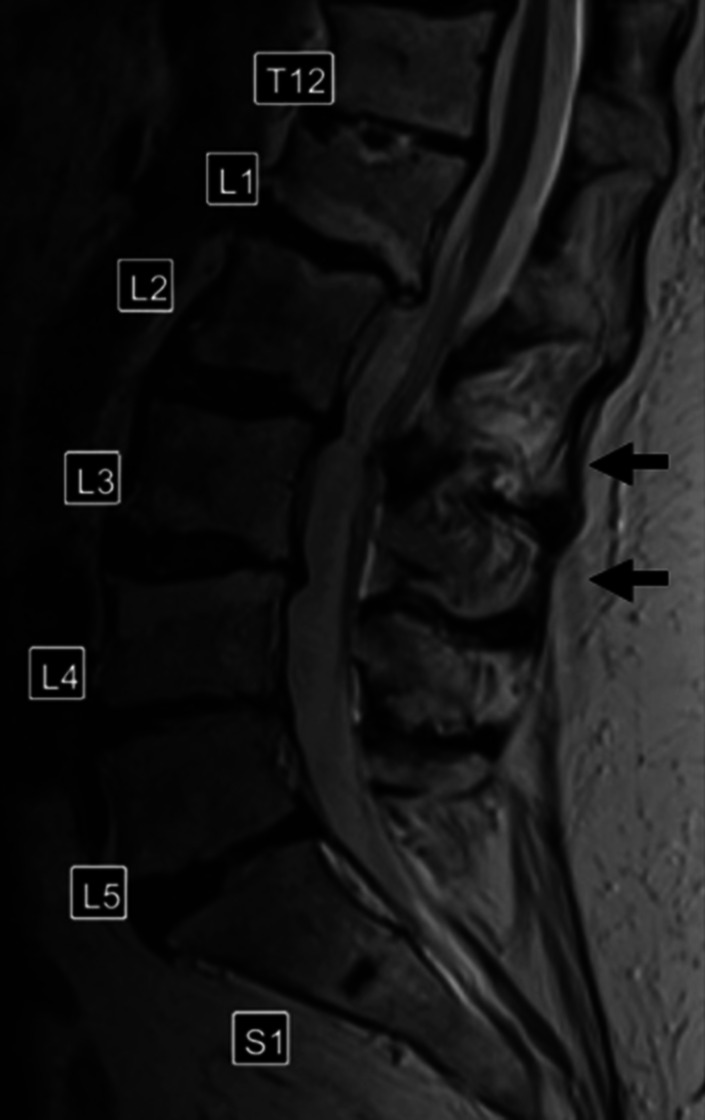Abstract
Baastrup’s disease, known colloquially as “kissing spine disease”, is a degenerative process, most commonly occurring in the lumbar spine, in which adjacent spinous processes closely approximate or even touch (Filippiadis et al. in Insights Imaging. 10.1007/s13244-014-0376-7, 2015). We present the case of an 86-year-old woman presenting with left low back, hip, and anterolateral thigh pain. Magnetic resonance imaging noted an approximation of the L2/3 spinous processes, with degeneration of the vertebral processes. This article is based on previously conducted studies and does not contain any studies with human participants or animals performed by any of the authors. Informed consent for publication was obtained from the participant.
Keywords: Baastrup’s disease, Degenerative spine disease, Spondylosis
Key Summary Points
| Baastrup’s disease occurs in the lumbar spine when adjacent spinous processes closely approximate or even touch, most often seen in elderly women, with symptomatology mimicking spinal stenosis, with localized back pain at the vertebral segment worsened with extension and improved with flexion. |
| Imaging will possibly show loss of disk height, spondylolisthesis, spondylosis, and osteophyte formation. |
| Although less common in presentation, Baastrup’s disease must be on the interventional pain medicine physician’s differential diagnosis when an elderly patient is presenting with symptoms similar to spinal stenosis. |
Case
Baastrup’s disease, known colloquially as “kissing spine disease”, is a degenerative process, most commonly occurring in the lumbar spine, in which adjacent spinous processes closely approximate or even touch [1]. Most often seen in elderly females, symptomatology mimics spinal stenosis with localized back pain at the vertebral segment worsened with extension and improved with flexion [2]. Lordosis of the lumbar spine with mechanical pressure over time produces repeated strain on the interspinous ligament, thinning it, with resultant collapse of the spinous process. Baastrup’s disease is commonly associated with loss of disk height, spondylolisthesis, spondylosis, and osteophyte formation [3]. Magnetic resonance imaging (MRI) of the lumbar spine can sometimes illustrate interspinous ligament bursitis characterized as a fluid-like intensity between the affected spinous processes [1].
Our case involved an 86-year-old woman with a history of chronic osteoarthritis and left low back, hip, and anterolateral thigh pain. She had undergone previous intra-articular hip injections with no relief of symptomatology. MRI radiographic findings (Fig. 1) demonstrated the vertebral spinous processes of the L2 and L3 levels approximating, almost touching. The treatment course of Baastrup’s disease includes conservative management, with non-steroidal anti-inflammatory drugs and percutaneous intervention. Although controversial, surgical removal of the inflicted spinous processes may be indicated in medically refractory cases.
Fig. 1.

T2-weighted sagittal magnetic resonance image (MRI) of the lumbar spine displaying collapse of L2/3 spinous processes. Degeneration and extreme lordosis of the vertebral column can also be seen throughout
Acknowledgements
Funding
No funding or sponsorship was received for this study or publication of this article.
Authorship
All named authors meet the International Committee of Medical Journal Editors (ICMJE) criteria for authorship for this article, take responsibility for the integrity of the work as a whole, and have given their approval for this version to be published.
Compliance with Ethics Guidelines
This article is based on previously conducted studies and does not contain any studies with human participants or animals performed by any of the authors. Informed consent for publication was obtained from the participant.
Disclosures
Ruben H. Schwartz, Ivan Urits, and Omar Viswanath have nothing to disclose.
Footnotes
Enhanced Digital Features
To view enhanced digital features for this article go to 10.6084/m9.figshare.9934235.
References
- 1.Filippiadis DK, Mazioti A, Argentos S, Anselmetti G, Papakonstantinou O, Kelekis N, Kelekis A. Baastrup’s disease (kissing spines syndrome): a pictorial review. Insights Imaging. 2015 doi: 10.1007/s13244-014-0376-7. [DOI] [PMC free article] [PubMed] [Google Scholar]
- 2.Kuramoto A, Chang L, Graham J, Holmes S. Lumbar spinal stenosis with exacerbation of back pain with extension: a potential contraindication for supine MRI with sedation. J Neuroimaging. 2011;21(1):92–94. doi: 10.1111/j.1552-6569.2009.00382.x. [DOI] [PMC free article] [PubMed] [Google Scholar]
- 3.Beks JWF. Kissing spines: fact or fancy? Acta Neurochir. 1989;100(3–4):134–135. doi: 10.1007/BF01403600. [DOI] [PubMed] [Google Scholar]


